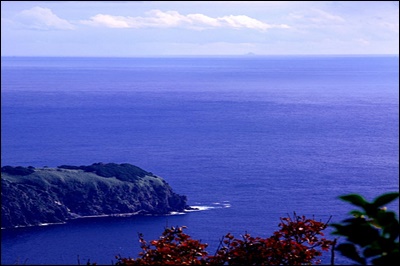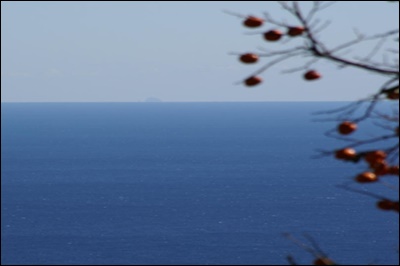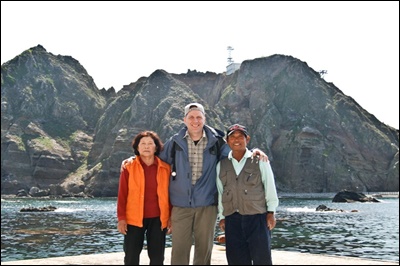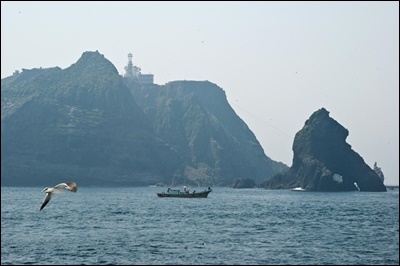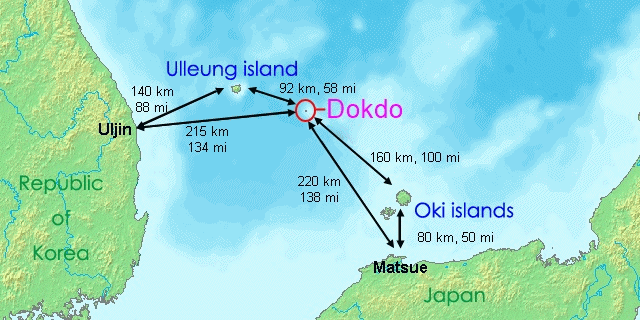 Dokdo (called Liancourt Rocks by some nations and Takeshima by Japan) is 215 kms from mainland Korea and 250 kms from Japan proper. The nearest land mass is Korea’s Ulleung-do Island at about 87 kms away. The islets are visible from Korea’s Ulleungdo on fair days. The nearest Japanese territory Oki Islands is 157 kms away.
Dokdo (called Liancourt Rocks by some nations and Takeshima by Japan) is 215 kms from mainland Korea and 250 kms from Japan proper. The nearest land mass is Korea’s Ulleung-do Island at about 87 kms away. The islets are visible from Korea’s Ulleungdo on fair days. The nearest Japanese territory Oki Islands is 157 kms away.
Dokdo is never visible from Japan’s Oki Islands. (Dokdo – A Study of Visibility and Territorial Perceptions) The total area of the islets is about 187,450 square meters, with their highest point at 169 meters in the western islet. The western islet is about 88,640 square meters in area; the eastern islet about 73,300 square meters.
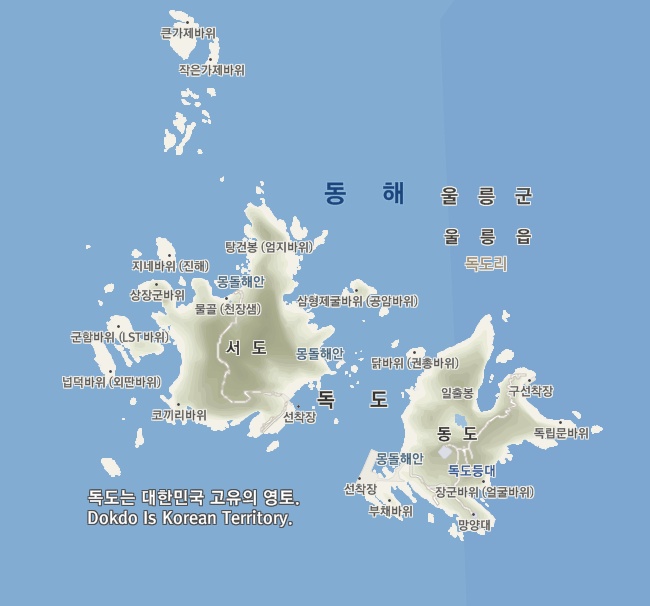 Dokdo Island is composed mainly of two islets, 150 meters apart (Seodo and Dongdo in Korean, Nishi-jima and Higashi-jima in Japanese) both literally meaning western island and eastern island respectively). The western islet is the larger of the two islets. Altogether, there are about 90 islets and reefs, volcanic rocks formed in the Cenozoic era. Dokdo is located at about 131.52. East longitude and about 37.14. North latitude. The western islet is located at 37.14.31.N, 131.51.55.E and the eastern islet is located at 37.14.27.N, 131.52.10.E. The western islet consists of a single peak and features many caves along the coastline. (Pictures of Korea’s Ulleungdo and Dokdo.)
Dokdo Island is composed mainly of two islets, 150 meters apart (Seodo and Dongdo in Korean, Nishi-jima and Higashi-jima in Japanese) both literally meaning western island and eastern island respectively). The western islet is the larger of the two islets. Altogether, there are about 90 islets and reefs, volcanic rocks formed in the Cenozoic era. Dokdo is located at about 131.52. East longitude and about 37.14. North latitude. The western islet is located at 37.14.31.N, 131.51.55.E and the eastern islet is located at 37.14.27.N, 131.52.10.E. The western islet consists of a single peak and features many caves along the coastline. (Pictures of Korea’s Ulleungdo and Dokdo.)
The cliffs of the eastern islet are about 10 to 20 meters high. There are two caves giving access to the sea, as well as a crater. A total of 37 of these islets are recognized as permanent land. In 2006, a geologist reported that the islets formed 4.5 million years ago and are quickly eroding. The map to the left shows Dokdo and all rocks that surround the two main islets. Note the cement mooring area located on the East Island. The path on the East Island is used by ROK Police to patrol the island and to access observation barracks. (click picture for larger image)
Photographs of Dokdo From Korea’s Ulleungdo Island
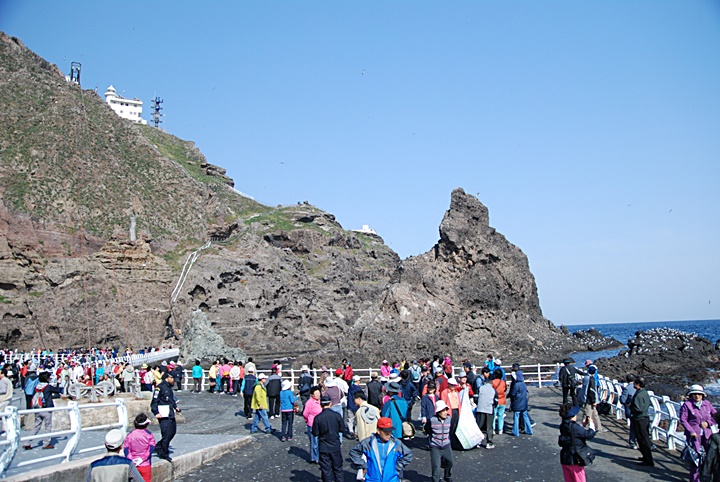 There is regular ferry service from Ulleungdo. There were 1,507 and 1,597 recorded tourists in 2003 and 2004 respectively. Due to their status as a nature reserve, special permits are required for tourists seeking to land on the islets rather than just circling them. In 2005, only 41,000 traveled to the islets with the number exceeding 100,000 in 2007. That year, the maximum of daily visitors to the islets was raised to 1,800, drawing more tourists to the area. As a result, Dokdo’s number of tourists has risen dramatically.To the right, an image of Korean vacationers on Dokdo’s East Island with the watchtower and lighthouse in the background. According to Ulleung Island and the Dokdo Administration Office Sunday, 132,558 visitors came to Dokdo last year. The figure includes those who entered the islet or circled around it. The number is an increase of some 4,000 people from the previous year’s 128,000. May had the largest number of visitors at 25,626 due to the clear weather, followed by 23,212 in August. Some 106,000 actually set foot on the island, while the other 26,000 simply circled around the islets due to the harsh weather. Other than on passenger ships, 2,714 people visited the islets in helicopters, or on naval vessels and administrative ships.
There is regular ferry service from Ulleungdo. There were 1,507 and 1,597 recorded tourists in 2003 and 2004 respectively. Due to their status as a nature reserve, special permits are required for tourists seeking to land on the islets rather than just circling them. In 2005, only 41,000 traveled to the islets with the number exceeding 100,000 in 2007. That year, the maximum of daily visitors to the islets was raised to 1,800, drawing more tourists to the area. As a result, Dokdo’s number of tourists has risen dramatically.To the right, an image of Korean vacationers on Dokdo’s East Island with the watchtower and lighthouse in the background. According to Ulleung Island and the Dokdo Administration Office Sunday, 132,558 visitors came to Dokdo last year. The figure includes those who entered the islet or circled around it. The number is an increase of some 4,000 people from the previous year’s 128,000. May had the largest number of visitors at 25,626 due to the clear weather, followed by 23,212 in August. Some 106,000 actually set foot on the island, while the other 26,000 simply circled around the islets due to the harsh weather. Other than on passenger ships, 2,714 people visited the islets in helicopters, or on naval vessels and administrative ships.
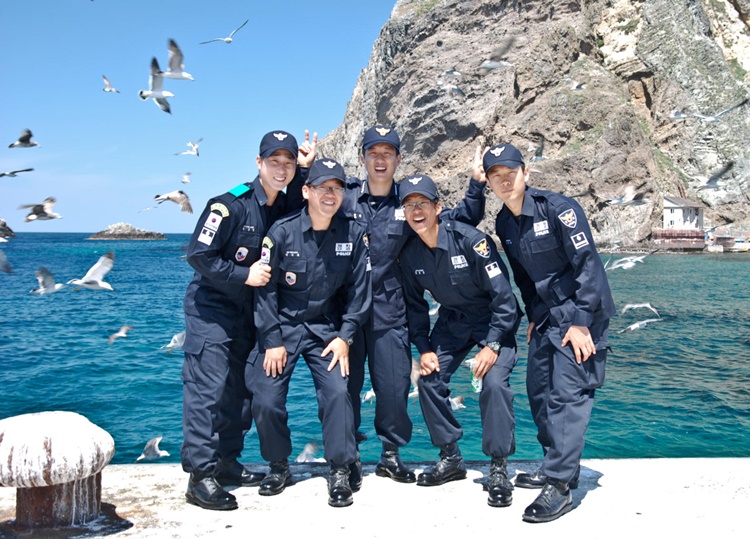 There are approximately 37 South Korean police that guard the islets, also there are Ministry of Maritime Affairs &Fisheries personnel, and three lighthouse keepers living on the islets in rotation. In the past, several fishermen also lived there temporarily. In 2005, the first recorded wedding ceremony was held on Dokdo Island. The South Korean couple chose the location to protest against Japanese territorial claims.To the left, ROK Security Police on Dokdo Island enjoy time off from their duty for pictures. In the background is the house of Dokdo’s only residents Kim Seong Do (passed away on October 21, 2018) and his wife Kim Shin Yeol. (Click picture for larger image.)
There are approximately 37 South Korean police that guard the islets, also there are Ministry of Maritime Affairs &Fisheries personnel, and three lighthouse keepers living on the islets in rotation. In the past, several fishermen also lived there temporarily. In 2005, the first recorded wedding ceremony was held on Dokdo Island. The South Korean couple chose the location to protest against Japanese territorial claims.To the left, ROK Security Police on Dokdo Island enjoy time off from their duty for pictures. In the background is the house of Dokdo’s only residents Kim Seong Do (passed away on October 21, 2018) and his wife Kim Shin Yeol. (Click picture for larger image.)
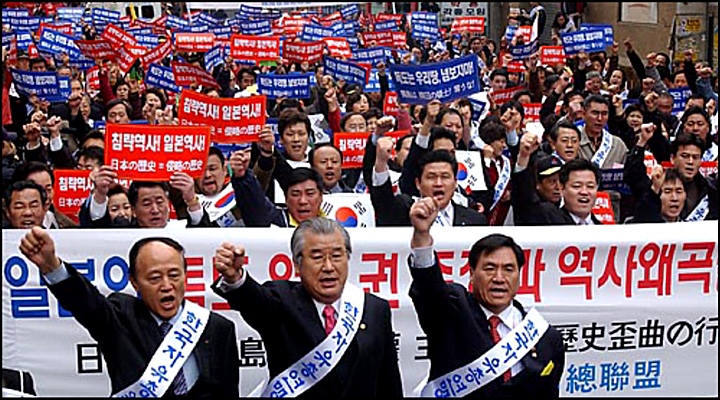 Korea and Japan have a long, complex history of cultural exchange, war, and political rivalry. The islets are the last disputed territory between Korea and Japan following World War II. Although Japan’s MOFA insists Allied Command granted Dokdo to Japan after the Second World War, there was no mention of Dokdo in the Japan Peace Treaty, leaving the issue unsettled. Because of the apparent inseparability of Japan’s 1905 “terra nullius” annexation of Dokdo and Japan’s colonization of the Korea, Japan’s demands to claim Dokdo cause outrage from Korean citizens. ( Korea’s Political Situation in 1905 When Japan Seized Dokdo – Takeshima Island ) To the right: Korean citizens protest Japan’s claim to Dokdo accusing Japan’s Government of whitewashing her past aggressions and colonial past.
Korea and Japan have a long, complex history of cultural exchange, war, and political rivalry. The islets are the last disputed territory between Korea and Japan following World War II. Although Japan’s MOFA insists Allied Command granted Dokdo to Japan after the Second World War, there was no mention of Dokdo in the Japan Peace Treaty, leaving the issue unsettled. Because of the apparent inseparability of Japan’s 1905 “terra nullius” annexation of Dokdo and Japan’s colonization of the Korea, Japan’s demands to claim Dokdo cause outrage from Korean citizens. ( Korea’s Political Situation in 1905 When Japan Seized Dokdo – Takeshima Island ) To the right: Korean citizens protest Japan’s claim to Dokdo accusing Japan’s Government of whitewashing her past aggressions and colonial past.Although claimed by both Korea and Japan, Dokdo Island is currently administered by the Republic of Korea. Both nations’ claims extend back at least several hundred years. Significant arguments supported by a variety of historical evidence have been presented by both parties, which have been challenged by counter-arguments with varying degrees of success. North Korea supports South Korea’s claim.

